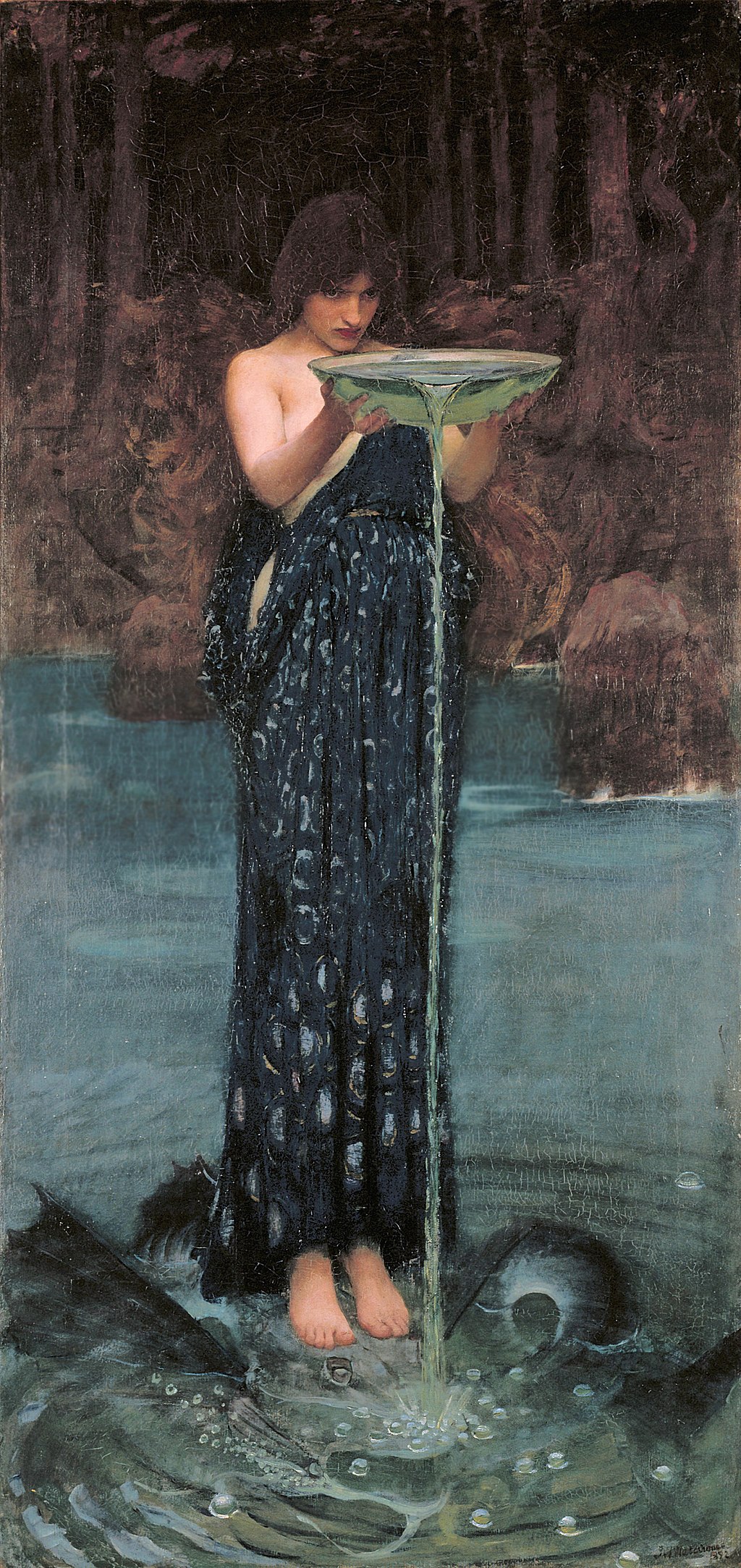
“Circe Invidiosa,” which in Latin means “Jealous Circe” by John William Waterhouse, portrays Circe, poisoning the water to turn Scylla, her rival into “a hideous monster.”
Circe is a goddess of magic, or sometimes an enchantress from Greek mythology, and Scylla was a beautiful nymph who gets turned into the monster.
In Latin, invidia is the sense of envy, a “looking upon” associated with the evil eye. Invidia or envy is one of the Seven Deadly Sins in Christian belief. Invidia is also the Roman name for the ancient Greek goddess, Nemesis.
In this painting, Waterhouse has expertly invested his main subject with an aura of menace, with deep greens and blues and the echo of straight vertical lines emphasizing the inevitability of her intent.
This painting by Waterhouse is his second depiction of Circe, following his painting “Circe Offering the Cup to Ulysses” in which the sorceress Circe offers Odysseus (called Ulysses by the Romans) a cup containing a potion with which she seeks to bring him under her spell.
Waterhouse again returned to the subject of Circe a third time with his painting of “The Sorceress.”
Waterhouse worked in the Pre-Raphaelite style, several decades after the breakup of the Pre-Raphaelite Brotherhood.
The Brotherhood included artists such as Dante Gabriel Rossetti, John Everett Millais, and William Holman Hunt.
Waterhouse embraced the Pre-Raphaelite style even though it had gone out of fashion in the British art scene.
Pre-Raphaelites
The Pre-Raphaelites was a group of English painters, poets, and art critics, founded in 1848. The group intended to reform art by rejecting what it considered the mechanistic approach first adopted by the artists who succeeded Raphael and Michelangelo, hence the name “Pre-Raphaelite.”
The Pre-Raphaelite Brotherhood sought a return to the abundant detail, intense colors, and complex compositions of Pre-Raphaelite Italian art.
The Pre-Raphaelites focused on painting subjects from modern life, and literature often used historical costumes for accuracy. They painted directly from nature itself, as accurately as possible, and with intense attention to detail.
The Pre-Raphaelites defined themselves as a reform movement, created a distinct name for their art, and published a periodical to promote their ideas.
A later, medieval influence extended the movement’s power into the twentieth century with artists such as John William Waterhouse.
Circe Invidiosa
- Title: Circe Invidiosa
- English: Jealous Circe
- Artist: John William Waterhouse
- Medium: Oil on canvas
- Date: 1892
- Style: Pre-Raphaelite
- Dimensions: 180.7 × 87.4 cm (71.1 × 34.4 in)
- Museum: Art Gallery of South Australia
John William Waterhouse
- Name: John William Waterhouse
- Movement: Pre-Raphaelite
- Born: 1849 – Rome, Papal States
- Died: 1917 (aged 67) – London, England, United Kingdom
- Nationality: British
- Notable works:
- The Lady of Shalott
- The Favorites of the Emperor Honorius
- Circe Invidiosa
- Diogenes
- I Am Half-Sick of Shadows, Said the Lady of Shalott
- Hylas and the Nymphs
- Echo and Narcissus
- Ulysses and the Sirens
- Consulting the Oracle
- A Tale from the Decameron
- Circe Offering the Cup to Ulysses
- Saint Eulalia
Circe and Witchcraft in Ancient Greece
A Tour of the Art Gallery of South Australia
- “A break away!” by Tom Roberts
- “A holiday at Mentone” by Charles Conder
- “Dandenongs from Heidelberg” by Charles Conder
- “A Summer Morning” by Rupert Bunny
- “Circe Invidiosa” by John William Waterhouse
- “The Favorites of the Emperor Honorius” by John William Waterhouse
- Melencolia I by Albrecht Dürer
Exploring Pre-Raphaelite Art
- By John Everett Millais
- Isabella
- Christ in the House of His Parents
- The Martyr of Solway
- Ophelia
- Blow Blow Thou Wind
- By John William Waterhouse
- The Lady of Shalott
- The Favorites of the Emperor Honorius
- Circe Invidiosa
- Diogenes
- I Am Half-Sick of Shadows, Said the Lady of Shalott
- Hylas and the Nymphs
- Echo and Narcissus
- Dante Gabriel Rossetti
- Lady Lilith
- Marie Spartali Stillman
- Love’s Messenger
~~~
“Great events make me quiet and calm;
it is only trifles that irritate my nerves.”
– Queen Victoria
~~~
Photo Credit: John William Waterhouse [Public domain], via Wikimedia Commons
Popular this Week








 Sponsor your Favorite Page
Sponsor your Favorite Page SEARCH Search for: Search Follow UsJoin – The JOM Membership Program
Sponsor a Masterpiece with YOUR NAME CHOICE for $5
Share this:
- Tweet
